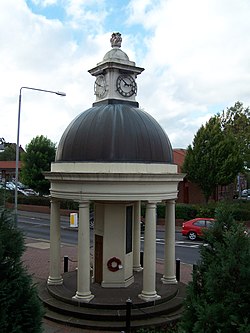Kimberley, Nottinghamshire
| Kimberley | |
| Nottinghamshire | |
|---|---|
 Kimberley Chapel of Rest on Knowle Hill | |
| Location | |
| Grid reference: | SK502447 |
| Location: | 52°59’51"N, 1°15’4"W |
| Data | |
| Population: | 6,849 |
| Post town: | Nottingham |
| Postcode: | NG16 |
| Dialling code: | 0115 |
| Local Government | |
| Council: | Broxtowe |
| Parliamentary constituency: |
Broxtowe |
Kimberley is a town in Nottinghamshire, lying six miles north-west of Nottingham along the A610. The town grew as a centre for coal mining, brewing and hosiery manufacturing. Together with the neighbouring villages of Giltbrook and Greasley, it has a population of around 6,500 people.
There has been no mining nor hosiery manufacturing in the town for many years and the local brewery was sold and closed at the end of 2006.
History
Kimberley is referred to as Chinemarelie in the Domesday Book of 1086, which records that after the Norman Conquest the manor came into the hands of William de Peveril.[1] The Peverils lost control when they supported the losing side in the civil war which preceded the accession of Henry II in 1154. The King became the owner of the land. King John of England granted land in the area to Ralph de Greasley in 1212 who took up residence at Greasley Castle and also at around this time to Henry de Grey whose son re-built Codnor Castle on the site of an earlier castle established by William Peveril.[2]
Ralph de Greasley's land passed by inheritance and marriage to Nicholas de Cantelupe who took part in Edward III's Scottish campaigns and also the Battle of Crécy. Nicholas founded Beauvale Priory using part of his Kimberley holding in 1343.
The lands of the Kimberley estate which Cantelupe retained passed by inheritance and marriage to John Lord Zouch who died at the Battle of Bosworth Field in 1485, fighting for the doomed Richard III. He was posthumously found guilty of high treason and his property forfeit to the new King, Henry VII. John Savage received this part of Kimberley in gratitude for his efforts on behalf of Henry VII at Bosworth. The Savage family sold this land to the Earl of Rutland in the early 17th century. The Duke of Rutland's Kimberley estates were sold in parcels in the early 19th century.[2]
That part of Kimberley which had been granted to Beauvale Priory fell to the Crown in the days of King Henry VIII during the Dissolution of the Monasteries and was redistributed. By 1627 it had come through inheritance and marriage to Arthur Capell, 1st Baron Capell of Hadham. Capell though was beheaded in 1649 having fought for the Royalists in the English Civil War. Arthur's son was created Earl of Essex in 1661.[2] In 1753 the land was bought by Sir Matthew Lamb whose grandson William Lamb, later 2nd Viscount Melbourne, became Prime Minister in 1834. The Lamb's Kimberley estates passed by marriage to the 5th Earl Cowper in 1805 and on the death of the 7th Earl in 1913 were sold off in pieces.[2]
Airships over Kimberley
Airships have flown over Kimberley on a number of occasions. The R101 flew over Kimberley during a trial flight on 18 October 1929, the year before it crashed with the loss of most of its passengers and crew during a flight to India.[3] During a bombing raid on the Bennerley and Stanton Ironworks during World War One, a German Zeppelin airship, L.20 (LZ 59) overflew Kimberley.[4]
Kimberley today

Kimberley is currently noted as being amongst the best value places to live in Nottinghamshire, providing a high standard of living with good access to local facilities and major transport routes, but with house prices close to half that of many other parts of Nottingham.
One of Kimberley's most notable structures is its unusual war memorial, in the form of a rotunda which is used as the emblem of Kimberley School.
On the South side of Kimberley lies Swingate, which has many different walking and cycling routes into the woods and surrounding countryside.
Brewery
Kimberley Brewery was taken over by Greene King in a multimillion-pound deal which marks the end of the traditional Kimberley Ales as ale brewing will now cease and there will only be a distribution centre in the area.
The Kimberley Brewery has within its boundaries a geological Site of Special Scientific Interest (SSSI). It is listed under the title of "Kimberley Railway Cutting"[5] as an important location for Permian Gymnosperm fossils. The Permian - Carboniferous unconformity can be found in the Kimberley Railway Cutting.
Sport

- Cricket: Kimberley Institute Cricket Club
- Football: Kimberley Town FC, Kimberley Miners Welfare, and AFC Kimberley
- Rifle shooting: Awsworth - Kimberley & District Rifle Club
Outside links
- Kimberley Railway Cutting – English Nature
- Kimberley Railway Cutting photos
References
- ↑ Domesday Book: A Complete Transliteration. London: Penguin, 2003. ISBN 0-14-143994-7 p.772
- ↑ 2.0 2.1 2.2 2.3 Lee, J.M.,. A Brief History of Kimberley.
- ↑ Plumb, Arthur. Kimberley in old picture postcards Volume 6.
- ↑ Phyllis Drew. Chinemarelian (Kimberley) Historical Society Newsletter 32.
- ↑ "Kimberley Railway Cutting". http://www.english-nature.org.uk/special/sssi/sssi_details.cfm?sssi_id=1000862.
Books
- Domesday Book: A Complete Transliteration. London: Penguin. 2003. ISBN 0-14-143994-7.
- Ottewell, David (2001). Old Kimberley. Stenlake Publishing. ISBN 1-84033-155-0.
- Lee, John.M. (2001). A Brief History of Kimberley (First ed.).
- Plumb, Arthur (1993). Kimberley in old picture postcards. European Library. ISBN 90-288-4669-7.